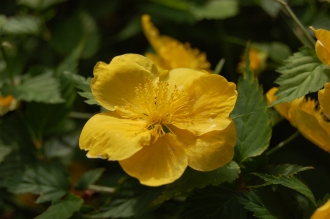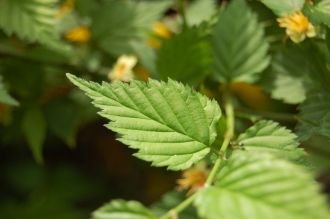Position: Full sun to partial shade
Soil: Moist, well drained
Flowering period: Mid spring
Eventual Height: 3m
Eventual Spread: 3m
Hardiness: 3a, 3b, 4a, 4b, 5a, 5b, 6a, 6b, 7a, 7b, 8a, 8b, 9a
Family: Rosaceae
Kerria japonica is a deciduous, vigorous, shrub with an upright habit. Its leaves are ovate with serrate margins and an acute tip, up to 10cm long and 4cm broad. Its stems are bright green. Its yellow flowers are solitary, up to 6cm across and appear in sprays. Its roots produce runners which enables its spread.
Kerria japonica, commonly known as Bachelors Buttons or the Japanese Rose, is native to East China, Japan and Korea. Kerria japonica is the sole species in the genus.
The etymological root of the binomial name Kerria is named after William Kerr, a plant collector for Kew who studied under Joseph Banks and introduced the genus to Europe with this variety. Japonica is derived from the Latin meaning ‘from Japan’.
The landscape architect may find Kerria japonica useful for planting in large blocks or difficult to access locations where maintenance will be low.
Ecologically, Kerria japonica flowers are attractive to bees and other nectar loving insects.
Kerria japonica prefers moist, humus rich, well-drained soils. It tolerates most pH of soil.
Kerria japonica requires little maintenance. Old shoots may be trimmed back after flowering to allow new growth to thrive. If the plant becomes too thick it may be split in autumn. It should be noted that when pruning this plant it will only flower on new growth.
![]()
Landscape Architecture







Leave a comment